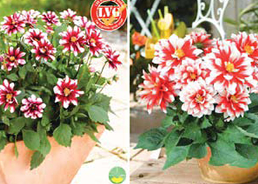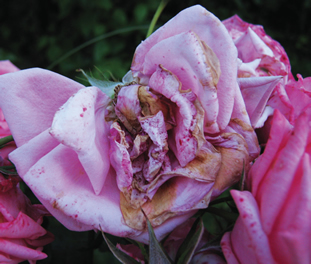BREEDERS BRIEFS
“No one thought bi-colored flowers would become popular”
 “A couple of years ago, no one would have thought that bi-colored or color changing flowers would become popular. Now, they are hot all over the world”, says Yoav Scholz of GGG Grünewald, a breeder and propagator of bedding and balcony plants.
“A couple of years ago, no one would have thought that bi-colored or color changing flowers would become popular. Now, they are hot all over the world”, says Yoav Scholz of GGG Grünewald, a breeder and propagator of bedding and balcony plants.
However, not only is the demand for colors constantly changing, so are the genetics of many traditional varieties. “When breeding new varieties, we need to take into account the entire production chain from the cutting, growing, logistics and the finished product from our customer to the retail. A good example to illustrate this trend is with our Dahlia ‘Starlias’ series. We are always workingto keep this ‘old plant’ attractive by adapting to new trends quickly.”
More open to bi-colors
According to Scholz, people are more open to new colors at the moment. “All over the world, we notice an increase in demand for striking colors and especially the bi-colored varieties. Approximately five years ago, when we just introduced the Dahlia “Starlias’ series, there was no market for bi-colored varieties, but now, our bi-colored dahlias are the top sellers in the ‘Starlias’ series,” says Scholz.

 Botrytis is one of the most damaging pathogens with stems, leaves, flowers, fruit and seedlings all being potential victims. Many growers are familiar with the symptoms of Botrytis, but for some, the first encounter with this pathogen results in severe plants losses therefore early detection and control are vital if the disease is to be prevented from rapidly spreading though a crop.
Botrytis is one of the most damaging pathogens with stems, leaves, flowers, fruit and seedlings all being potential victims. Many growers are familiar with the symptoms of Botrytis, but for some, the first encounter with this pathogen results in severe plants losses therefore early detection and control are vital if the disease is to be prevented from rapidly spreading though a crop. If you ask Bayer East Africa management what is the main difference between their company’s business model and that of most other players in the market for Agrochemicals, they will answer “While the traditional business model in this market is product driven and supply-pushed, ours is the exact opposite: Customer-driven, demand-pulled”. While Bayer East Africa is certainly not the only company to have such business model, it is true that this is their business model, reflected in their strategy and moves in the market. With a focus on emerging countries and niche markets, Bayer East Africa manages a portfolio of many active ingredients.
If you ask Bayer East Africa management what is the main difference between their company’s business model and that of most other players in the market for Agrochemicals, they will answer “While the traditional business model in this market is product driven and supply-pushed, ours is the exact opposite: Customer-driven, demand-pulled”. While Bayer East Africa is certainly not the only company to have such business model, it is true that this is their business model, reflected in their strategy and moves in the market. With a focus on emerging countries and niche markets, Bayer East Africa manages a portfolio of many active ingredients. Flower prices over the last six years have grown at only 7 percent whereas costs of production in Kenya have risen by more than 50 percent. This has impacted on the profits and ability to reinvest and expand. Principal amongst these cost increases are power and labour. In addition, the industry has also sought to absorb cost increases through improved efficiencies. This was said by Mr. Richard Fox, Kenya Flower Council Chairman.
Flower prices over the last six years have grown at only 7 percent whereas costs of production in Kenya have risen by more than 50 percent. This has impacted on the profits and ability to reinvest and expand. Principal amongst these cost increases are power and labour. In addition, the industry has also sought to absorb cost increases through improved efficiencies. This was said by Mr. Richard Fox, Kenya Flower Council Chairman. Popularly known as IFTEX, the show brings buyers from across the world to meet with growers who have staged a spectacular show of unarguably one of the best mixes of flowers the world can get, as well as the industry supply chain of products and services that together deliver the final bouquet to the customer’s vase.
Popularly known as IFTEX, the show brings buyers from across the world to meet with growers who have staged a spectacular show of unarguably one of the best mixes of flowers the world can get, as well as the industry supply chain of products and services that together deliver the final bouquet to the customer’s vase. Kenya’s floriculture sub-sector is courting the United States, Chinese, Korean, Australian and Japanese markets as it seeks to expand from traditional European Union (EU) market.
Kenya’s floriculture sub-sector is courting the United States, Chinese, Korean, Australian and Japanese markets as it seeks to expand from traditional European Union (EU) market.